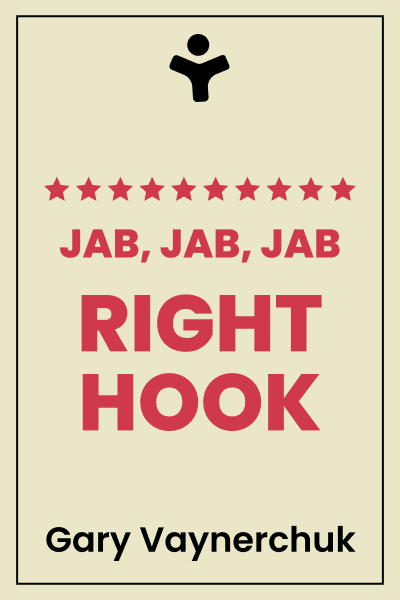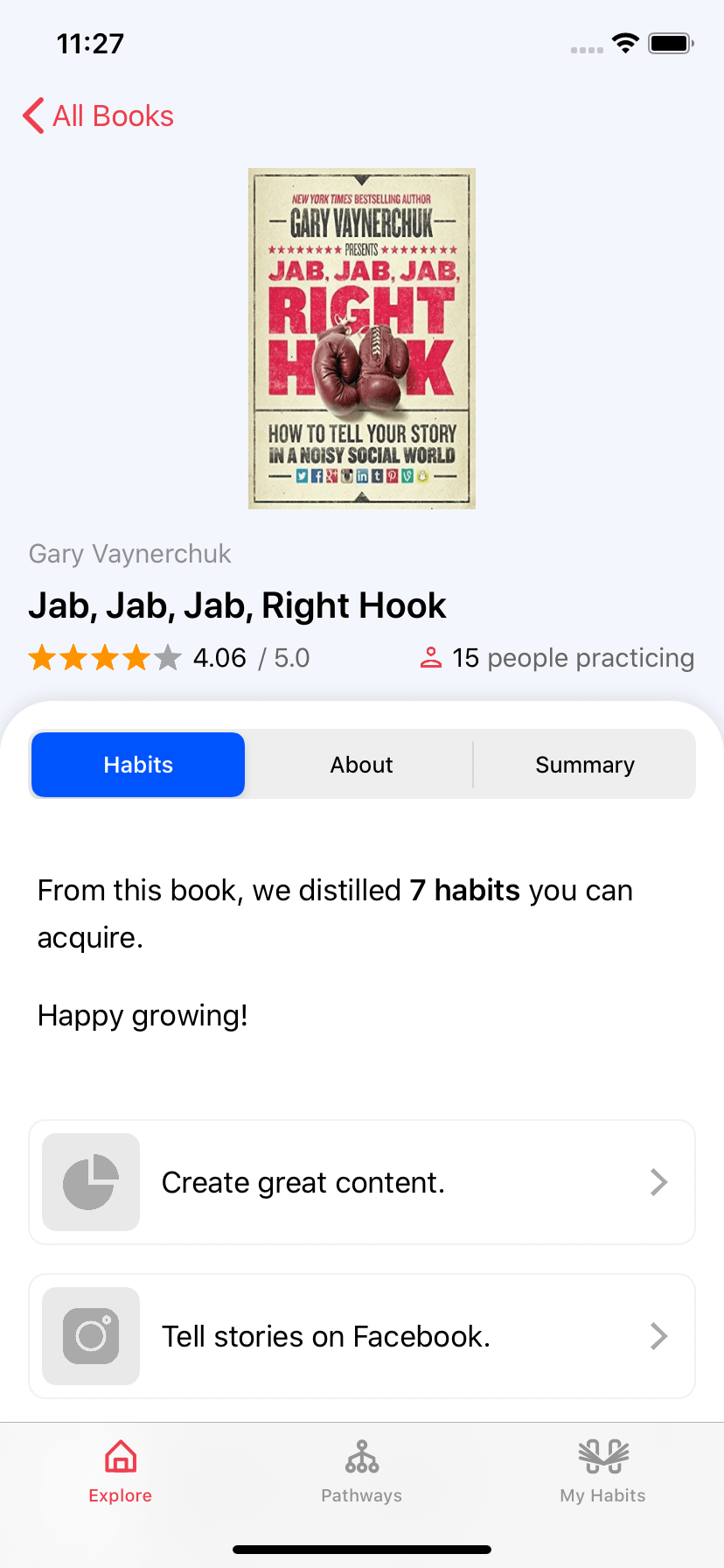
Jab, Jab, Jab, Right Hook: How to Tell Your Story in a Noisy Social World
Read in the App
Full actionable summary
This book teaches two things: how to create great content and how to create and publish content for each of the biggest social networks. As each social network is different, the dynamic there is different as well.
The main message of this book is that too much selling in your content is not how social media should be used. Instead, the best strategy to follow is to share value, give more, and, when the time comes, sell. Just like the title of this book, Jab, Jab, Jab, Right Hook, which really means “give, give, give, sell.” Most people might have difficulty understanding what giving is. It’s not about bragging or selling. It’s about creating content that is either funny, informative, generous, or inspiring.
What You'll Learn
This summary distills the key insights from Jab, Jab, Jab, Right Hook: How to Tell Your Story in a Noisy Social World into actionable steps you can apply immediately. Perfect for busy professionals who want to learn and implement quickly.
Read in the App
Get the full actionable summary with our mobile app
Key Insights & Chapters
The Setup
“Social media is like crack - immediately gratifying and hugely addictive”
Social media has made it easier to reach people. However, the constant and noisy stream of information, imagery, and interaction has altered the way that people want to interact with brands and services. People now crave a social layer to everything.
Marketing can no longer be divided into strict categories of traditional, digital and social - the social must be weaved in at every level. This means you need to encourage the social aspect through all your marketing communications. For example, leave a reply on Twitter, gamify a banner ad, engage on a news aggregator, or send people to Facebook at the end of your radio spot.
Most companies have caught onto the fact that social media presents the biggest opportunity for brand growth. However, they often make the mistake of repurposing the same content across all the social media sites, and this is why their strategy fails.
You want to create shareable, relevant, value-driven content that makes customers pay attention, remember your name, and then pass on your content. This means first learning each social media platform like you would a different language. Then, tailor and tell your story in a way that compels people to buy what you’re selling.
People don’t buy instantly, hence the title of this book: Jab, Jab, Jab, Right Hook. You’ll have to first jab them with lightweight pieces of content that make them feel good, so they’ll be familiar with your brand. After a few Jabs, deliver your Right hook: a call to action that benefits your business. Basically, give, give, give, and then sell.
A great marketing story compels people to do what you want them to do. For example, a phone company wants people to sign up for a subscription. Disney wants people to come and spend money at their park. Nonprofits want to move people to make a decision. All your content on the various social media platforms - the jabs and the right hooks - should be centered around this key principle.
There’s no one blueprint for creating social media content, it’s highly dependent on factors unique to your situation. You’ll have to experiment to find out what works: use slang, add a GIF at the end, try out different hashtags, etc, and then measure the differences in impact.
Actions to Take
Great Content & Complete Stories
“Content is king, but context is god”
There is a ton of noise on social media, and only outstanding content can cut through it all. Remember that each social media platform has its own unique language, culture, sensibility, and style. Some are better for text-heavy posts while you’d need rich visuals for others. Even the small details matter - some allow hyperlinks while others don’t.
People are on social media to get some value out of it, in whatever form. What is your audience looking for when they go to Instagram? What about Facebook? Do they want to get a few minutes respite from a busy day, learn something new, get updated on current events, feel a sense of connection, or brag about themselves? Create native content that actually resonates with the people who look at it by focusing on storytelling, rather than selling.
Micro-content combined with community management is the definition of effective social media management. Create content based on what your audience is talking about, and when they start talking about something different, talk about that instead. You have to be alert and responsive - trends change quickly and you want to be one of the first so you actually get the attention.
Actions to Take
“Familiarity breeds acceptance.”
Most people are familiar with Facebook. They use it to connect, socialize and catch up on what others are doing. People share information on what they’re reading, listening to, wearing, and eating, what causes they’re interested in, what ideas they’re working on, what jobs they’re looking for, etc.
Engagement is the only metric you need to focus on when building a community on Facebook. The more people engage with your posts, the more often they’ll see your new ones on their newsfeed, and the more likely it is that their friends and acquaintances will see them too. Purchases may grow your app’s userbase, but it does nothing for your social media presence. Likes, shares, comments, and clicks are what you need.
Actions to Take
“Twitter is the cocktail party of the Internet - a place where listening well has tremendous benefits.”
Marketing on Twitter is a little different - success doesn’t come from your content alone, but rather, the valuable context that is added to it.
Most people use Twitter for news and information. However, popular tweets don’t just share a news story, they interpret and remix it to tell a story that’s often more memorable than the original piece of news. Basically, add infotainment, not information.
Hashtags are an important aspect of Twitter; the limited character count means you need to be discerning with the hashtag trends you decide to invest in. The right hashtag can turn your tweet viral, but it must be authentic and relevant to your business while also sounding native to Twitter.
Actions to Take
“Aspiration and acquisition are two of the most powerful human drivers that lead people to buy, and Pinterest can satisfy both.”
Pinterest is a commonly overlooked social media platform, but it’s very popular in some communities. It allows users to collect research and ideas on an online bulletin board, similar to hanging art in your house, decorating your desk with bobbleheads, or sticking bumper stickers onto your car.
Some small businesses that experimented with Pinterest in the early days saw as much as a 60% increase in revenue. This isn’t surprising - with the right collection of images, you can create a beautiful visual reminder of the dreams your product can help others achieve. It also gives you the ability to redirect potential customers to your website as hyperlinks can be added to pins.
Visually compelling images are a must on Pinterest, but a short title that adds context is important too. For example, imagine you run a local tea shop. Instead of posting pictures labeled “Green Tea”, “Black Tea”, etc, get creative. Try “Tea You Drink After a Bad Day” or “Tea To Celebrate the Summer”. Appeal to the dreams that people have and they’ll be more likely to add it to their board and remember your name.
Actions to Take
“It’s that scale at low cost that makes up for Instagram’s lack of social value.”
Think of Instagram as a slightly more interactive experience than a print magazine. Although you can’t really redirect traffic to your website and you have to put in significant efforts to create original content, you can reach an engaged and vast audience.
The key to Instagram is authenticity - be artistic, not commercial.
Actions to Take
Tumblr
“If Twitter is hip-hop, Tumblr is indie rock”
Tumblr appeals to niche hobbies, particularly, art, photography, music, and graphic design. Although it doesn’t have the scale of Pinterest or Instagram, it’s highly brandable and acts as an exhibition space for your micro-content. Plus, you can use GIFs to tell your story in a unique way.
On Tumblr, connections are made based on your interests and not necessarily your friends. Basically, if you post the right things for your audience, they will find you. Take advantage of their tags, you can add as many as you like.
(Note: This book was published in 2013, and Gary Vaynerchuk has not published anything new on Tumblr since 2016. Social media changes very fast, and this might mean that there are better social networks to invest your time in.)
Actions to Take
Opportunities in Emerging Networks
“Every year, the world becomes a little smaller, a little more social, a little more connected.”
To create content for social media is to share your experiences, thoughts, and ideas with the world in real-time. This is a crucial aspect of the online experience - people expect and crave a social layer to their interactions. It’s likely that even platforms that are not currently overtly social right now will adapt to this trend soon enough, and may be worth checking out. Remember, being the first brand to advertise on an up-and-coming platform can make your name unforgettable.
For example, LinkedIn is working hard to encourage content creation on their platform by enabling sharing and introducing “LinkedIn Influencers” who contribute articles on their topic of expertise. It’s an exclusively business-oriented platform, making it a great platform for B2B marketers (unlike Facebook). Long-copy is encouraged here - the users come to the site for information; they’re often looking for a job and need some kind of edge. The value you offer them may be different from what you offer users on Twitter or Instagram, but LinkedIn users are hungry for it.
Google+ is an example of a platform with potential, although this is still questionable. It could boost your SEO rankings on Google Search, however, it’s not as widely used as Facebook. Still, Google Glass could take off over the next few years and replace smartphones, driving the popularity of Google+ along with it. One benefit is that since the platform is so similar to Facebook, you won’t have to reinvent your marketing strategy.
Actions to Take
Effort
“Effort is the great equalizer.”
Each comment you get on your jabs or right hooks is an opportunity to create a relationship with a potential customer. Engage with comments on your posts in a creative and sincere manner and you’ll find it much easier to create your community.
People want to believe you care about them both as a customer and an individual. It’s the effort that counts - big brands may be able to jump in on more conversations, but volume alone doesn’t mean anything. The quality of your conversations matters the most.
Actions to Take
Get Full Access in the App
Download Mentorist to explore detailed action steps, track your progress, and build lasting habits.

Experience the Full Summary
Read comprehensive summaries and track your progress with our mobile app